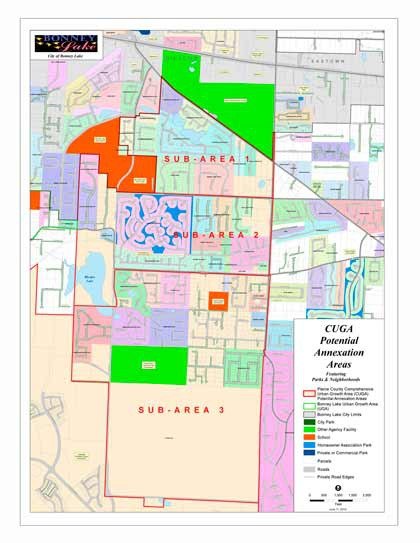The city of Bonney Lake appears poised to support an annexation vote that could increase the city’s population by approximately 50 percent.
During its workshop meeting July 5, the council moved to the next full meeting a resolution calling for a vote on bringing three County Urban Growth Area sections into the city.
Known as sub-areas 1, 2 and 3, if annexed they would add more than 1,860 acres and more than 7,000 people to the south end of the city.
The council appears poised to run all three areas as a single annexation, to pass or fail as a group.
Deputy mayor Dan Swatman said the “bigger picture” points to those areas being urbanized and in need of city services, such as police. He also said that adding them to Bonney Lake would help spread the city’s tax burden to the new residents as well, making it easier to fund roads and other large projects in the future.
“I think they can be a vibrant part of our city,” he said.
Swatman also said to him, sub-area 3 would be the plum of the group. Sub-area three is a mostly empty parcel of land on which the development known as “Plateau 465” is to be located. Bringing the area in the city would allow city standards to be applied to building and would allow the city to collect permit and impact fees from the area.
“There’s a lot of reason to do it quicker than not,” he said.
Councilmember Mark Hamilton said he was concerned that the additional population and acreage could put unwanted stress on city services at a time when the city is forced to take furlough days to help keep finances in check.
“You’re going to put a major strain in the city’s ability to provide services,” he said, adding that the upheaval created could last years.
Hamilton recommended annexing the areas separately.
“Once we’ve proven ourselves on sub-area 1, then go after 2 and 3,” he said.
City Administrator Don Morrison said he would rather run an election once than three separate times.
“I’d rather go through it once and be done with it,” he said, adding that the areas are “basically a series of subdivisions” and there would not be enough revenue generated unless all three are brought in.
“I think there’s enough lead time and I think enough planning can be done,” Morrison said of staffing concerns.
According to a study done by the city, the areas should generate about $3.5 million in additional revenues or the city while additional staffing – part of a plan also created to help prepare for annexation – would only cost approximately $1.4 million, which includes additional police as well as other city employees.
In discussions of staffing, councilmembers wondered if the number of officers projected would be enough.
“I think the public safety aspect is probably the most important to the people in the annexation area,” councilmember Laurie Carter said.
“They need a police department out there,” Councilmember Jim Rackley said.
Police Chief Mike Mitchell told the council he was “really comfortable” with the staffing projections for police, calling them a “good starting point” and saying more can be added if needed.
Most councilmembers appeared to support putting annexation on the ballot.
“We can’t have future population if we don’t have someplace to put them,” Councilmember Dan Decker said.
“The people in the annexation area, it’s their decision to make,” Swatman said.
If passed, the election would occur in early 2011 at a cost of approximately $15,000. If approved, the areas could be part of the city by early 2012.



